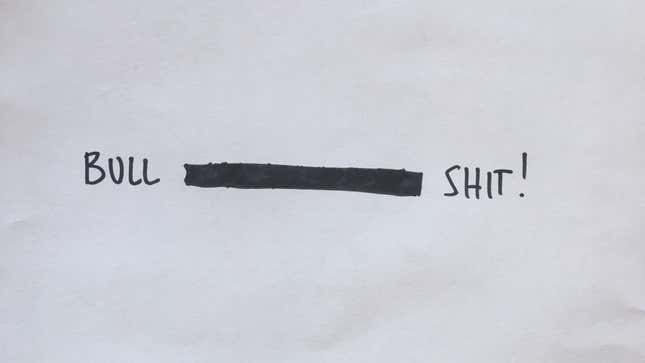
So you’ve got the hyphen. That’s the “-” guy. It joins words together. When you put “-ass” at the end of an adjective, you are using a hyphen. Also when you are separating out the syllables of a word, like for effect—“pre-pos-ter-ous”—that is also a hyphen job. The hyphen’s function in that case is to make clear that these things are joined. The hyphen is an okay-ass punc-tu-a-tion mark.
Then there is what is called the “figure dash.” That, too, is the “-” guy. It has the same meaning and use as the hyphen, but when you use it to connect numbers, rather than words or parts of words, you call it a “figure dash.” Your phone number (555-123-4567) is connected by figure dashes. But let’s be real, here: Those are just frickin’ hyphens. The “figure dash” is bullshit.
Then, if you are a regular reader of this website, you likely know the “em dash,” which several of us, most especially me, overuse badly. (My editor, who also overuses it, added two of them to the first paragraph.) That’s the “—” guy. The long one. It has many uses, but mostly you will see it on either side of an interpolation—not an aside (which would be better marked with parentheses)—in the middle of a sentence. In writing that contains dialog, the em dash also is good for marking an interruption. Like so:
“I thought that Deadspin was a sports bl—”
“Roast in hell, motherfucker!”
The em dash is good, in my opinion. Sometimes people try to make em dashes out of a pair of hyphens, but that is baloney. Put some respect on the em dash! On a Mac keyboard, you make an em dash by pressing Option, and Shift, and the hyphen key. On a PC keyboard, you rest your head and cry about your hopeless government-contractor job until you get fired for being bad at it, or at least that is how I remember that going.
And then, would you believe it, there is a whole other dash. This is the dreaded “en dash.” The en dash is shorter than an em dash but longer than a hyphen. So, like, the em dash is the width of an m, and the en dash, wouldn’t you know, is the width of an n.
The en dash does a bunch of stuff. It denotes a closed range or continuum of values, e.g. “I am going to shoot you with 6–10 bullets for writing this blog” or “From Jul. 2–4, 2019, Albert Burneko did a short blog about punctuation marks and started a fight over The Lion King in Slack.” But it can also denote a relationship between two separate or even opposed things, like in a sports score: “Led by LeBron James, Anthony Davis, and Kawhi Leonard, the Los Angeles Lakers defeated the Washington Wizards 173–39.”
The en dash can also do other stuff. For example, it can help to sort out PEMDAS weirdness when you’re sticking a prefix (“non-” for example) onto a phrase that is already compound and joined by a hyphen. Like if you want to specify that the oven you are sticking your head into, unlike many similar models, is not the self-cleaning type, you can say that it is non–self-cleaning. The en dash, there, is ugly-looking and bad, but in theory it perhaps clarifies that what you’re saying is “this oven does not clean itself,” rather than “this oven only cleans things that are not itself.”
All in all, you might be thinking, this makes the en dash a fine and useful item of punctuation. What you have failed to consider is that having this piece of punctuation means that I will forget to use it sometimes in instances in which it would be appropriate, and that this is intolerable. Also, not that anybody actually writes things by hand anymore, but I actually can’t imagine anything more desperate and miserable than trying to maintain consistent lengths of en dash and em dash and hyphen in handwritten text. Imagine your fury if you turned in a handwritten essay on Some Themes In The Scarlet Letter and your frickin’ teacher marked up your frickin’ dashes because they were wider than your lowercase n or whatever. Imagine handing a lovingly crafted 400-word hot sports take to your editor and getting your dang dash usage corrected. You would want to do a murder, and it would be punctuation’s fault. No jury would convict you, provided that jury knew enough about how punctuation works.
So what I am proposing is that there should be two kinds of dashes. There should be a short dash (-) and a long dash (—). The short dash can be for basically everything that you don’t use an em dash for. The long dash can be for the em dash stuff. Ranges can just be short-dashed. Sports scores, too. Nobody is going to think that the Lakers defeated the Wizards by every number between 39 and 173. When I write that you are a goober-ass loser, nobody will wonder if what I mean is that you have somehow lost a coalition between the opposed forces of “goober” and “ass.” It’ll be fine.
But what about the PEMDAS stuff, you’re now asking. How will we make sense of—
You can go to hell! This blog is over!